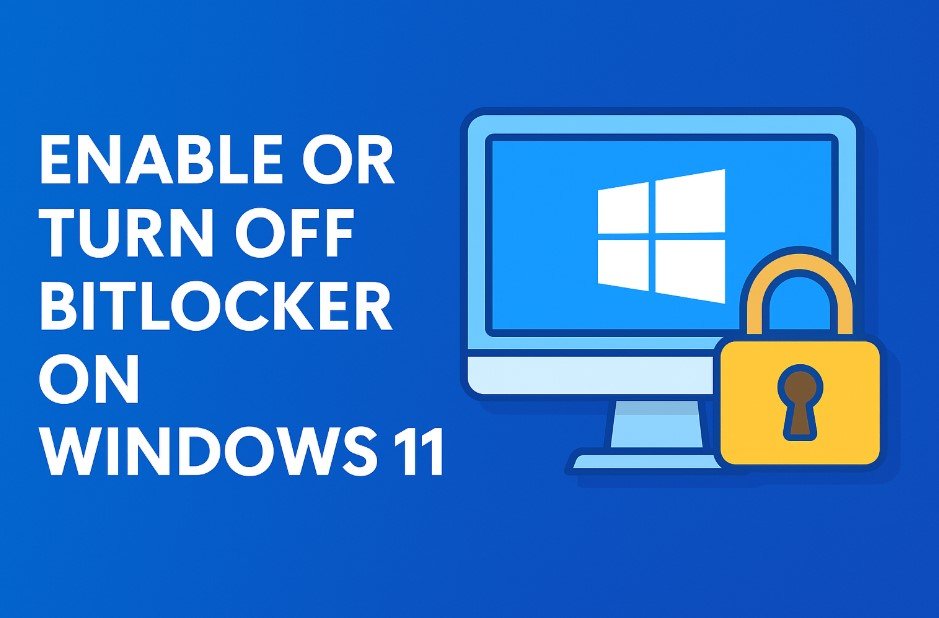Tech
How to Enable or Turn Off BitLocker on Windows 11

BitLocker is a built-in encryption tool in Windows 11 that protects your data by encrypting the entire drive. It helps keep your information secure from unauthorized access, especially if your device is lost or stolen. In this guide, you’ll learn how to enable and disable BitLocker in Windows 11, along with managing recovery keys and understanding how it works.
What is BitLocker?
BitLocker is a security feature from Microsoft designed to encrypt data on your hard drive. This makes the data unreadable to anyone without the correct password or recovery key. BitLocker utilizes the Trusted Platform Module (TPM) chip in your device to securely manage encryption and decryption processes.
You might see prompts to enter your BitLocker recovery key if Windows detects changes in your system’s configuration or during boot issues. Knowing how to manage BitLocker can help you prevent data loss and control access to your files.
Requirements to Use BitLocker on Windows 11
Before turning BitLocker on, ensure your device meets these requirements:
- A device running Windows 11 Pro, Enterprise, or Education (BitLocker is not available on Home edition)
- A TPM version 1.2 or higher
- At least two partitions on your drive: one for system boot and one for Windows
- Administrator privileges
How to Check If Your PC Has TPM
- Press Windows + R to open the Run dialog box.
- Type msc and press Enter.
- A window will appear showing the TPM version and status. If TPM is not available, BitLocker will require a USB startup key instead.
How to Enable BitLocker in Windows 11
Here are the steps to turn on BitLocker:
Step 1: Open Control Panel
- Press Windows + S and type “Control Panel.”
- Click on it from the results.

Step 2: Navigate to BitLocker Settings
- Click on System and Security

- Select BitLocker Drive Encryption

Step 3: Turn On BitLocker
- Find the drive you want to encrypt (usually C:)
- Click Turn on BitLocker

Step 4: Choose How to Unlock Your Drive
You’ll be asked how you want to unlock your drive during startup:
- Use a password
- Use a USB flash drive
Choose the option you prefer and follow the on-screen prompts.
Step 5: Backup Your Recovery Key
You’ll need this key if you ever forget your password. Windows will ask how you want to back it up:
- Save to your Microsoft account
- Save to a file
- Print the key
Save it securely. Do not skip this step.

Step 6: Choose Encryption Mode
Windows will offer two options:
- New encryption mode (best for fixed drives on this device)
- Compatible mode (best for drives that might be moved to older PCs)
Choose the mode that fits your needs.
Step 7: Start Encryption
- Click Start Encrypting
- The process may take time, depending on the size of your drive
Once completed, BitLocker is active and your drive is secure.
Check out: Download Bit.ly/windowstxt Windows 10 Activator TXT Free
How to Verify BitLocker is Active
You can check the encryption status by:
- Going to Control Panel > System and Security > BitLocker Drive Encryption
- The drive should show “BitLocker On”

You can also check using Command Prompt:
- Open Command Prompt as administrator
- Type manage-bde -status and press Enter
How to Pause or Resume BitLocker
BitLocker allows you to pause encryption temporarily:
- Go to BitLocker Drive Encryption settings
- Click Suspend protection
- Confirm by clicking Yes
To resume:
- Return to the same menu
- Click Resume protection
This is helpful if you’re updating BIOS or making system changes.
How to Turn Off BitLocker in Windows 11
If you no longer need encryption, here’s how to disable it:
Step 1: Open BitLocker Settings
- Go to Control Panel > System and Security > BitLocker Drive Encryption
Step 2: Select Your Drive
- Find the encrypted drive
- Click Turn off BitLocker

Step 3: Confirm Decryption
- Click Decrypt Drive
- Windows will begin removing encryption (this can take some time)
How to Manage BitLocker Recovery Keys
A BitLocker recovery key is a 48-digit numerical key that can unlock your drive if you forget your password or if the system detects an unauthorized change. It’s important to store it safely.
View or Back Up Your BitLocker Recovery Key
You can check and save your recovery key by following these steps:
- Open Control Panel
- Navigate to
System and Security > BitLocker Drive Encryption - Click
Back up your recovery keynext to the encrypted drive
You will have three options:
- Save to your Microsoft account
- Save to a file (preferably on an external drive)
- Print the key
If you chose to save it to your Microsoft account, you can access it at: https://account.microsoft.com/devices/recoverykey
Why You Might Need the Recovery Key
- System hardware changes
- BIOS or firmware updates
- Drive moved to another computer
- TPM firmware reset
- Lost or forgotten password
Keep at least one backup of your recovery key in a location separate from your PC.
Manage BitLocker with Command Prompt
Advanced users may prefer managing BitLocker using Command Prompt (CMD) or PowerShell. Here’s how you can perform basic tasks using manage-bde, the BitLocker command-line tool.
To Check BitLocker Status
manage-bde -status
This will show the encryption percentage, protection status, and whether a recovery key is saved.

To Enable BitLocker
manage-bde -on C: -RecoveryPassword
This starts encryption on the C: drive and sets up a recovery password.
To Turn Off BitLocker
manage-bde -off C:
This begins decrypting the C: drive.
Use Command Prompt only if you’re comfortable with technical steps. Errors can cause system issues, so always backup data before using command-line tools.
Troubleshooting Common BitLocker Issues
Sometimes BitLocker may cause problems or behave unexpectedly. Here are common issues and solutions.
Problem: BitLocker Asks for Recovery Key Every Boot
Solution:
- Check if Secure Boot is enabled in BIOS
- Ensure TPM is functioning properly
- Use
manage-bde -statusto check for any problems
Problem: Can’t Find Recovery Key
Solution:
- Check your Microsoft account
- Look for printed or saved files from when you first enabled BitLocker
- If using a work PC, ask your system administrator
If the key is completely lost and recovery is not possible, you may need to reinstall Windows, which erases all files.
Problem: Encryption Takes Too Long
Solution:
- Pause and resume the process later
- Check disk for errors with
chkdsk - Avoid using the PC heavily during encryption
Large drives or slow disk speeds can cause delays. Let encryption finish uninterrupted for best results.
BitLocker for External Drives
BitLocker To Go is a feature that allows you to encrypt USB flash drives and external hard disks.
Steps to Use BitLocker To Go:
- Plug in your USB or external drive
- Go to
Control Panel > BitLocker Drive Encryption - Click
Turn on BitLockernext to your USB drive - Choose a password or smart card to unlock
- Backup the recovery key
- Start encryption
The drive can now only be opened by entering the password. This is helpful if you store sensitive data on portable drives.
BitLocker vs Device Encryption
Some Windows 11 devices, especially newer laptops, come with Device Encryption pre-enabled. While similar to BitLocker, there are key differences:
| Feature | BitLocker | Device Encryption |
| Available on | Pro, Enterprise, Edu | Home, all editions |
| Manual control | Full control | Minimal control |
| Encryption settings | Configurable | Automatic and limited |
| TPM requirement | Yes | Yes |
If you need advanced features, such as encrypting specific drives or backing up recovery keys, BitLocker is the better option.
Is BitLocker Worth Using?
Yes, if:
- You store sensitive personal or work data
- You travel with your laptop often
- You share your PC with others
- You want added protection against theft
BitLocker is free with Windows 11 Pro or higher and provides strong security without needing extra software.
However, if you lose your password and recovery key, you may not be able to access your files. Always keep backups and store recovery keys securely.
Frequently Asked Questions (FAQs)
- Does BitLocker slow down my PC?
Minimal performance impact, especially on newer PCs. You may notice a slight delay during boot or encryption/decryption processes.
- Can I use BitLocker without TPM?
Yes, but you’ll need to change Group Policy settings and use a USB flash drive as a startup key.
- Is BitLocker available on Windows 11 Home?
No. BitLocker is only available on Windows 11 Pro, Enterprise, and Education editions.
- How do I find my BitLocker recovery key?
Check your Microsoft account or the backup location you chose when setting it up.
- Can I pause encryption halfway?
Yes, BitLocker allows you to pause and resume encryption at any time.
Conclusion
BitLocker is a powerful feature in Windows 11 that helps secure your files through encryption. Whether you’re enabling it for the first time or looking to turn it off, following the steps outlined in this guide will help you manage your data securely. Always back up your recovery key, and only disable BitLocker if you’re certain your data no longer needs protection.
For added peace of mind, consider enabling BitLocker on external drives and learning how to use Command Prompt for more control. With the right setup, BitLocker can be one of the best free security tools on your Windows 11 PC.
Check out: Why You Should Go Passwordless Using Windows Hello on Windows
-

 Social Media2 months ago
Social Media2 months agoWhat the “67” TikTok Meme Really Means
-

 Tech2 months ago
Tech2 months agoWhat To Do When Your Business Faces Network Vulnerabilities
-

 Self Improvement2 months ago
Self Improvement2 months agoUsing BCBS Rehab to Access Quality Addiction Care
-

 Games2 months ago
Games2 months agoPusoy Strategies for Play That Also Work in Pusoy Dos in English






